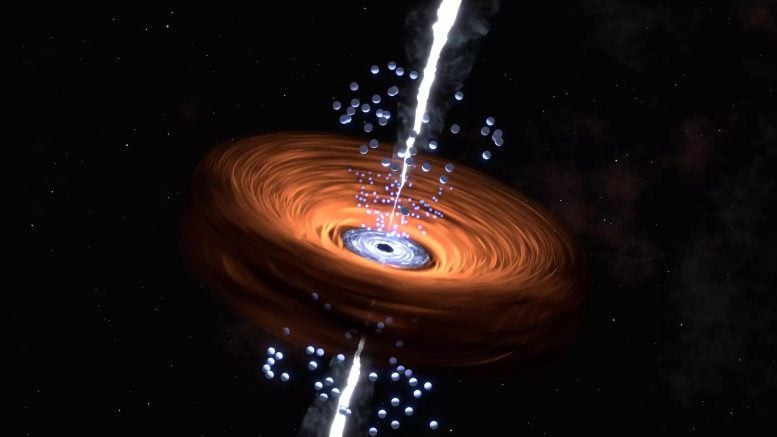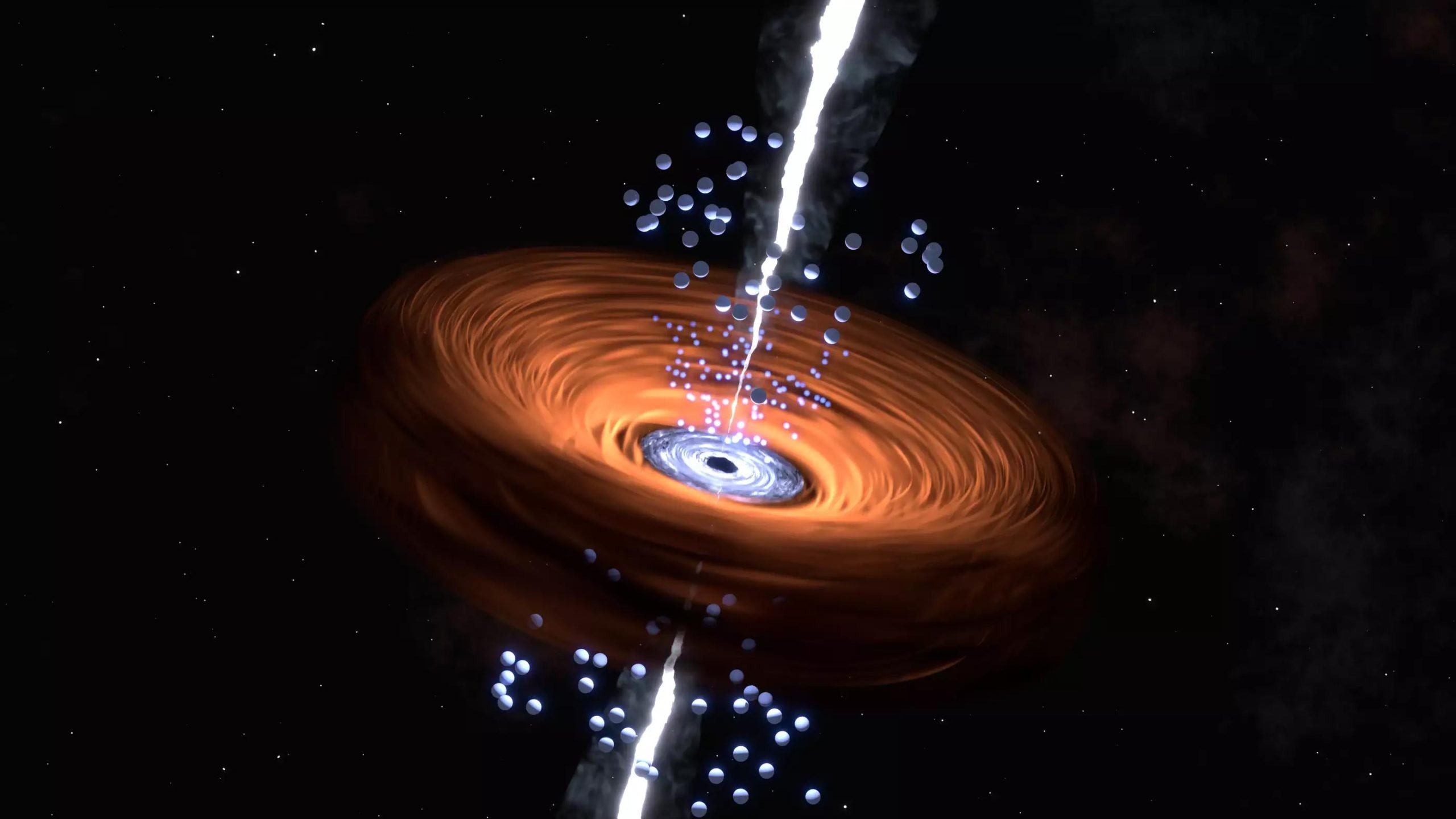
Artist’s impression of the bright core region of a quasar, an active galaxy. The supermassive black hole at the center is surrounded by a bright disk of gas and dust. The outermost dust component can obscure the view of the interior and shines mainly in the mid-infrared range, the light that can be analyzed by the James Webb Space Telescope. A beam of high-energy particles emerges into space from the immediate vicinity of the black hole perpendicular to the disk. Copyright: © T. Müller / MPIA
Surprisingly unsurprising: The black hole already weighed more than a billion solar masses in the early universe despite its average appetite.
Looking back at the early stages of the 13.8 billion year old universe, James Webb Space Telescope He observed a galaxy as it existed only 700 million years after the great explosionIt is confusing how. Black hole The black holes at their center may have already weighed a billion solar masses when the universe was still in its infancy. James Webb’s observations were designed to take a closer look at the feeding mechanism, but they found nothing out of the ordinary. Clearly, the black holes were indeed growing in a similar way to what happens today. But the finding is more important: It may show that astronomers know less about how galaxies form than they once thought. Still, the measurements are by no means disappointing. Quite the contrary.
The mystery of early black holes
The first billion years of the universe’s history pose a major challenge: the earliest known black holes at the centers of galaxies were surprisingly massive. How did they get so massive so quickly? The new observations described here provide strong evidence against some proposed explanations, especially against the “ultra-efficient feeding mode” of the first black holes.
Growth limits of supermassive black holes
Stars and galaxies have changed dramatically over the past 13.8 billion years, the age of the universe. Galaxies have grown larger and gained more mass, either by consuming surrounding gas or (sometimes) by merging with each other. For a long time, astronomers assumed that the supermassive black holes at the centers of galaxies would have gradually grown along with the galaxies themselves.
But black holes can’t grow arbitrarily fast. Matter falling onto a black hole forms a hot, bright “accretion disk.” When this happens around a supermassive black hole, the result is an active galactic nucleus. The brightest of these objects, known as quasars, are among the brightest astronomical objects in the entire universe. But that brightness limits the amount of matter that can fall onto a black hole: light exerts a pressure that can prevent additional matter from falling.
How did black holes get so massive so fast?
That’s why astronomers were surprised when observations of distant quasars over the past 20 years revealed black holes that were young, yet had masses as large as 10 billion solar masses. Light takes a long time to travel from a distant object to us, so looking at distant objects means looking into the distant past. We see the most distant known quasars as they were in an era known as the “dawn of the universe,” less than a billion years after the Big Bang, when the first stars and galaxies formed.
Explaining these early massive black holes poses a major challenge to current models of galaxy evolution. Could early black holes have been more efficient at accreting gas than their modern counterparts? Or could the presence of dust have affected quasar mass estimates in a way that led researchers to overestimate the mass of early black holes? There are several proposed explanations at this time, but none is widely accepted.
A Closer Look at the Early Growth of a Black Hole
Determining which explanations are correct—if any—will require a more complete picture of quasars than has been possible before. With the advent of the James Webb Space Telescope, and specifically the Mid-Infrared Imaging Reconnaissance Imager (MIRI), astronomers’ ability to study distant quasars has taken a huge leap. When measuring the spectra of distant quasars, MIRI is about 4,000 times more sensitive than any previous instrument.
Instruments like MIRI are built by international consortia, with scientists, engineers, and technicians working closely together. Naturally, the consortium is keen to test whether their instrument works as well as planned. In exchange for building the instrument, the consortium is typically given a certain amount of observing time. In 2019, years before JWST was due to launch, the European MIRI consortium decided to use some of that time to observe what was then the most distant quasar known, an object called J1120+0641.
Observing one of the oldest black holes
The observations were analysed by Dr Sarah Bossmann, a postdoctoral researcher at the Max Planck Institute for Astronomy and a member of the European MIRI consortium. MPIA’s contributions to MIRI include building a number of key interior parts. Bossmann was asked to join the MIRI collaboration specifically to provide expertise on how best to use the instrument to study the early Universe, and in particular the first supermassive black holes.
The observations were made in January 2023, during the James Webb Space Telescope’s first observation cycle, and lasted about two and a half hours. They are the first mid-infrared study of a quasar from the cosmic dawn, just 770 million years after the Big Bang (redshift z=7). The information comes not from an image, but from a spectrum: the breakdown of an object’s light into components of different wavelengths, similar to a rainbow.
Tracking fast moving dust and gas
The general shape of the mid-infrared spectrum (“continuous”) encodes the properties of a large ring of dust surrounding the accretion disk in typical quasars. This ring helps funnel matter into the accretion disk, “feeding” the black hole. The bad news for those who favor solving the problem of early massive black holes lies in the alternative growth pathways: the ring, and thus the feeding mechanism, in these very early quasars appears to be the same as in their more recent counterparts. The only difference is something that no model of early quasar rapid growth predicted: the dust temperature is slightly higher, about a hundred Kelvin warmer than the 1,300 Kelvin found in the hottest dust in less distant quasars.
The shorter wavelength part of the spectrum, dominated by emission from the accretion disk itself, shows us distant observers that the quasar’s light is not being dimmed by more dust than usual. Arguments that we may be overestimating the mass of the early black hole due to extra dust are also not the answer.
Early quasars are ‘shockingly normal’
The quasar’s outlined region, where clumps of gas orbit the black hole at speeds approaching the speed of light—which allows inferences about the black hole’s mass and the density and ionization of the surrounding matter—also appears normal. By almost all properties that can be inferred from the spectrum, J1120+0641 is no different from quasars of later times.
“Overall, the new observations add to the mystery: early quasars were shockingly normal. Regardless of the wavelengths at which we observe them, quasars are almost identical across all ages of the universe,” says Bosman. Not only the supermassive black holes themselves, but also their feeding mechanisms were fully “ripe” when the universe was only 5% of its current age. By ruling out a number of alternative solutions, the results strongly support the idea that supermassive black holes started out very massive, in astronomical terms: “primordial” or “massive.” Supermassive black holes did not form from the remains of early stars and then grow very quickly. They must have formed early on, with initial masses of at least a hundred thousand solar masses, perhaps by the collapse of early, massive gas clouds.
Reference: “A mature quasar at the dawn of the universe detected by JWST’s static-frame infrared spectroscopy” by Sarah E. I. Bosman, Javier Alvarez Marquez, Luis Colina, Fabian Walter, Almudena Alonso-Herrero, Martin J. Ward, Göran Östlin, Thomas R. Greif, Gillian Wright, Arjan Beck, Leendert Bogard, Karina Caputi, Luca Constantin, Andreas Eckart, Macarena Garcia Marin, Stephen Gellman, Jens Hjorth, Eduardo Ianni, Olivier Elbert, Iris Germain, Alvaro Labiano, Daniel Langerodi, Florian Peisker, Pierluigi Rinaldi, Martin Topinka, Paul van der Werf, Manuel Godel, Thomas Henning, Pierre-Olivier Lagag, Tom B. Ray, Ewen F. van Dischoeck and Bart Vandenbusche, 17 June 2024, Natural astronomy.
DOI: 10.1038/s41550-024-02273-0

“Typical beer advocate. Future teen idol. Unapologetic tv practitioner. Music trailblazer.”







More Stories
Boeing May Not Be Able to Operate Starliner Before Space Station Is Destroyed
How did black holes get so big and so fast? The answer lies in the darkness
UNC student to become youngest woman to cross space on Blue Origin